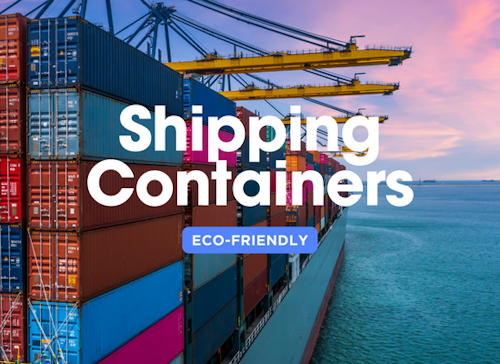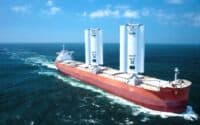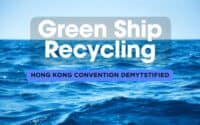The Rise of Eco-Friendly Shipping Containers

In an era where sustainability is increasingly at the forefront of global concerns, the shipping industry faces mounting pressure to adopt eco-friendly practices. Traditional shipping containers, typically made from energy-intensive materials like steel and aluminum, not only leave a substantial carbon footprint but also pose challenges in terms of waste disposal and recyclability. As the industry evolves, a promising solution emerges in the form of eco-friendly cargo shipping containers. These innovative containers, crafted from sustainable materials and equipped with advanced technologies, offer a pathway to a greener future. This article explores the benefits, challenges, and future potential of eco-friendly containers, highlighting how they are set to revolutionize the shipping landscape.
Environmental Impact of Traditional Shipping Containers
- Significant Carbon Footprint: Traditional steel and aluminum containers contribute heavily to global CO2 emissions.
- High Energy Consumption: The production process requires a large amount of energy, further exacerbating environmental concerns.
- End-of-Life Disposal Issues: Disposal and recycling of traditional containers often lead to additional environmental harm.
Emerging Trend: Eco-Friendly Cargo Shipping Containers
- Sustainable Materials: New containers are being made from recycled or biodegradable materials, reducing environmental impact.
- Energy-Efficient Technologies: Innovations such as solar panels and better insulation are becoming standard, enhancing energy efficiency.
- Economic and Operational Benefits: Beyond environmental advantages, eco-friendly containers can offer long-term cost savings and operational efficiencies.
| ShipUniverse: Eco-Friendly Materials for Shipping Containers | |||
|---|---|---|---|
| Material | Pros | Cons | Cost |
| Recycled Steel | High strength, readily available | Energy-intensive recycling | Moderate |
| Aluminum | Lightweight, corrosion-resistant | High cost, limited recyclability | High |
| Bamboo | Rapid growth, renewable | Durability concerns, requires treatment | Low |
| Composite Materials | Customizable, durable | Complex production, cost | Varies |
| Biodegradable Plastics | Eco-friendly, reduces plastic waste | Lower strength, limited applications | Low |
| Corten Steel | Corrosion resistance, durability | Higher initial cost | Moderate |
| Fiberglass | Lightweight, strong | Brittle, expensive | High |
| Carbon Fiber | High strength-to-weight ratio | Expensive, complex processing | High |
| Recycled Plastics | Recycled content, reduces waste | Quality variability, limited applications | Low |
| Wood-Plastic Composites | Durable, weather-resistant | Less structural strength | Moderate |
| Natural Fiber Composites | Eco-friendly, lightweight | Limited industrial use | Low |
| Magnesium Alloy | Lightweight, strong | Expensive, corrosion issues | High |
| Titanium | Extremely strong, lightweight | Very expensive, limited availability | Very High |
| High-Density Polyethylene (HDPE) | Durable, recyclable | Lower strength compared to metals | Moderate |
| Cork | Lightweight, renewable | Limited structural use, cost | Low |
The Need for Eco-Friendly Solutions in Shipping
Environmental Impact of Traditional Containers
- Carbon Footprint and Material Waste
- Traditional shipping containers are predominantly made from steel and aluminum, materials that require significant energy to produce, contributing to high carbon emissions. Each standard container can emit up to 5,000 kilograms of CO2 during its production, adding to the industry's overall carbon footprint.
- The manufacturing process not only consumes large amounts of energy but also leads to substantial material waste, further straining environmental resources.
- The Issue of Container Disposal and Recycling
- Disposal of traditional containers poses significant environmental challenges. Many containers are discarded after reaching the end of their life cycle, leading to waste accumulation in landfills.
- Recycling these containers is often problematic due to the mixed materials used in their construction, making it difficult to separate and properly process them for reuse.
Regulatory Pressures and Industry Trends
- International Regulations on Emissions and Waste
- Increasingly stringent international regulations are being implemented to curb emissions and manage waste in the shipping industry. These regulations mandate the reduction of greenhouse gas emissions and encourage the adoption of sustainable practices.
- Organizations like the International Maritime Organization (IMO) are pushing for lower sulfur emissions from ships and more responsible waste management, which includes the use of more sustainable materials in container production.
- The Industry's Shift Towards Sustainability
- The shipping industry is gradually embracing sustainability as a core principle, driven by consumer demand, regulatory pressures, and the potential for cost savings. This shift includes exploring new materials and technologies to create more environmentally friendly containers.
- Companies are increasingly recognizing the long-term benefits of sustainable practices, including improved brand image, compliance with regulations, and reduced operational costs through more efficient and eco-friendly technologies.
The Benefits of Eco-Friendly Containers
Environmental Advantages
- Reduction in Carbon Emissions
- Eco-friendly containers, made from sustainable materials and equipped with energy-efficient technologies, significantly reduce the carbon emissions associated with their production and operation. The use of recycled and renewable materials also cuts down on the need for new raw material extraction, further lowering the carbon footprint.
- Lower Waste Generation and Better Recyclability
- The design of eco-friendly containers focuses on minimizing waste generation. By using recyclable or biodegradable materials, these containers reduce the environmental burden associated with disposal. Additionally, their enhanced recyclability ensures that materials can be effectively reclaimed and reused, promoting a circular economy.
Economic and Operational Benefits
- Long-Term Cost Savings on Energy and Maintenance
- Although the initial investment in eco-friendly containers may be higher, they often result in significant long-term savings. Energy-efficient technologies, such as solar panels and advanced insulation, reduce operating costs by lowering energy consumption. Furthermore, the durable and high-quality materials used in these containers often require less maintenance, reducing repair and replacement costs over time.
- Enhanced Brand Image and Customer Appeal
- Adopting eco-friendly practices, including the use of sustainable containers, can greatly enhance a company's brand image. As consumers and businesses increasingly prioritize sustainability, companies that demonstrate a commitment to environmentally responsible practices can attract new customers and build stronger relationships with existing ones. This positive perception can lead to increased customer loyalty and a competitive edge in the market.
Challenges and Barriers to Adoption
High Initial Costs
- Investment Challenges for Shipping Companies
- One of the primary barriers to the widespread adoption of eco-friendly containers is the high initial investment required. The costs associated with research, development, and production of sustainable materials and technologies can be significant, posing financial challenges, especially for smaller shipping companies.
- Strategies for Cost Management and ROI
- To overcome these financial hurdles, companies can explore various strategies, such as seeking government subsidies and grants for green initiatives, forming partnerships to share costs, and implementing phased adoption plans. Additionally, a thorough analysis of the long-term return on investment (ROI) can help companies justify the initial expenditure, highlighting the potential for reduced operating costs and increased market appeal.
Technical and Logistical Hurdles
- Compatibility with Existing Infrastructure
- Integrating eco-friendly containers into the existing shipping infrastructure can pose technical challenges. These containers may require different handling equipment, storage facilities, or transportation methods, which can lead to additional costs and logistical complexities.
- Issues with Durability and Performance
- There are concerns about the durability and performance of some eco-friendly materials compared to traditional ones. While advancements are continually being made, ensuring that sustainable containers can withstand the harsh conditions of maritime transport remains a priority. Companies must carefully evaluate the durability and performance of these containers to ensure they meet industry standards and can be reliably used in various shipping conditions.
As the shipping industry navigates the challenges of the 21st century, the adoption of eco-friendly shipping containers stands out as a crucial step towards a sustainable future. By integrating innovative materials and energy-efficient technologies, these containers not only mitigate environmental impact but also offer economic advantages, from cost savings to enhanced brand reputation. While the journey towards widespread adoption may be met with challenges, the potential benefits far outweigh the obstacles. Embracing eco-friendly containers represents not just a commitment to sustainability but also a strategic investment in the future of global trade. As the industry continues to evolve, these green innovations will undoubtedly play a pivotal role in shaping a more sustainable and efficient world.
| ShipUniverse: Eco-Friendly Cargo Shipping Containers: Benefits and Challenges | |||
|---|---|---|---|
| Category | Aspect | Description | Examples/Notes |
| Environmental Advantages | Reduction in Carbon Emissions | Eco-friendly containers reduce emissions during production and operation. | Use of recycled materials, renewable resources. |
| Lower Waste Generation and Better Recyclability | Focus on using materials that are easier to recycle and generate less waste. | Biodegradable materials, recyclable designs. | |
| Economic & Operational Benefits | Long-Term Cost Savings | Savings on energy and maintenance over time. | Energy-efficient technologies like solar panels, durable materials. |
| Enhanced Brand Image | Improves public perception and customer appeal. | Attracts eco-conscious customers, improves market position. | |
| Challenges & Barriers | High Initial Costs | Significant investment required for sustainable materials and technologies. | ROI considerations, potential for subsidies or partnerships. |
| Technical & Logistical Hurdles | Challenges with integrating into existing infrastructure and ensuring durability. | Need for compatibility with current systems, ensuring performance standards. | |

Do you have a Maritime Product or Service that may be of interest to Shipowners? Tell us about it here!
Do you have feedback or insights? Please reach out to editor @ shipuniverse.com




